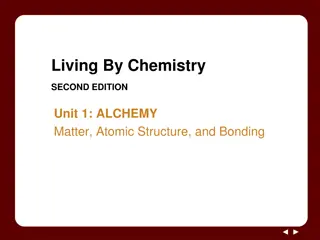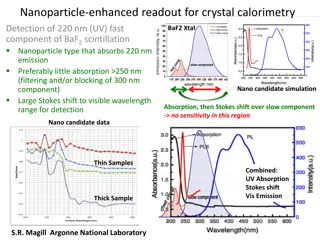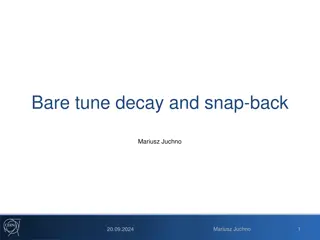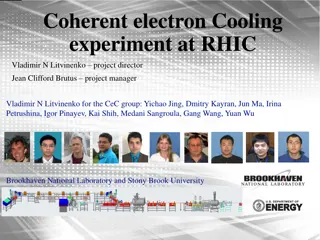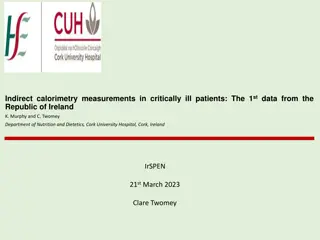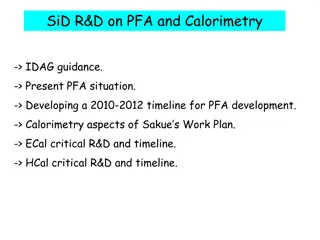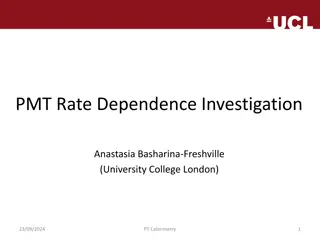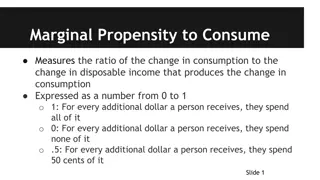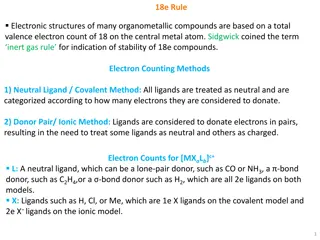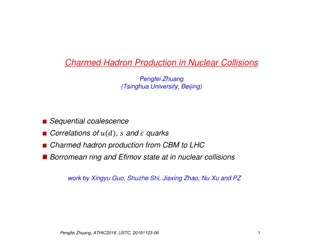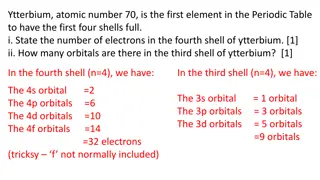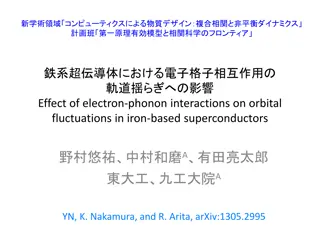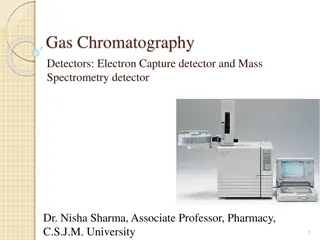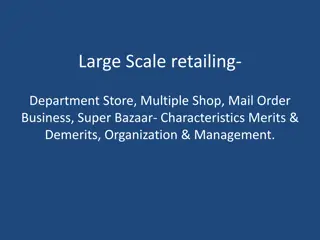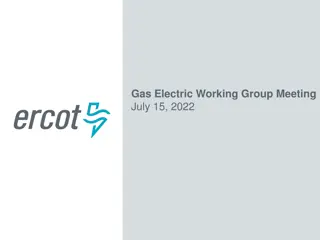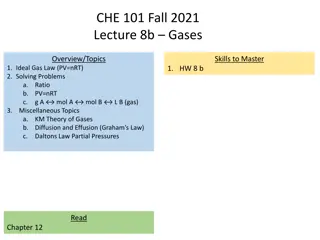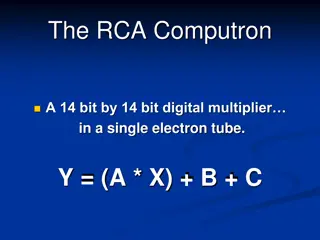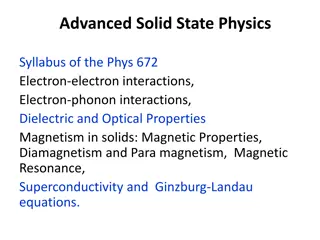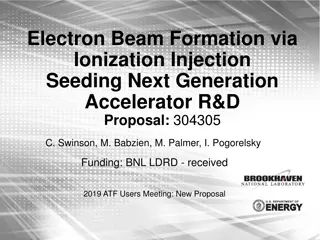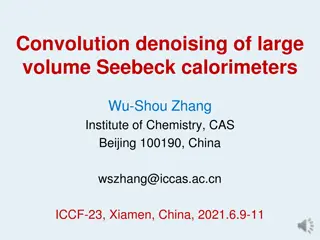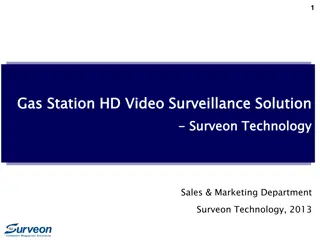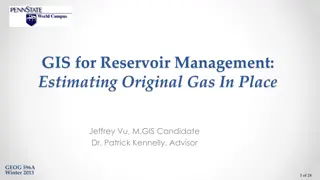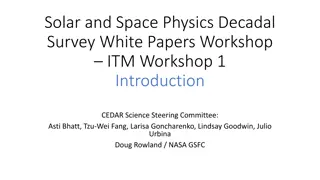Application of Large-Scale Gas Electron Multiplier Technology to Digital Hadron Calorimetry by Andy White
Andy White from the University of Texas at Arlington presented on the application of Large-Scale Gas Electron Multiplier (GEM) technology to digital hadron calorimetry at the SiD Workshop in SLAC 2012. The study focuses on developing precision calorimetry for future accelerators using Double GEM layers, construction, and testing of GEM chambers of various sizes, and integrating analog (KPiX) and digital (DCAL) readouts. The goal is to establish operating conditions for large GEM/DHCAL chambers, with prototypes like the 30x30 GEM chamber showcasing advanced features and potential applications.
- Gas Electron Multiplier
- Digital Hadron Calorimetry
- Precision Calorimetry
- SiD Workshop
- Particle Flow Calorimetry
Download Presentation

Please find below an Image/Link to download the presentation.
The content on the website is provided AS IS for your information and personal use only. It may not be sold, licensed, or shared on other websites without obtaining consent from the author. Download presentation by click this link. If you encounter any issues during the download, it is possible that the publisher has removed the file from their server.
E N D
Presentation Transcript
Application of Large Scale Gas Electron Multiplier Technology to Digital Hadron Calorimetry Andy White University of Texas at Arlington For GEM DHCAL Group SiD Workshop SLAC 2012 Introduction KPiX and DCAL Integration FTBF Beam Test Setup Beam Test Analysis Results Large Chamber Development GEM DHCAL Plans Summary 1 GEM DHCAL A. White
Motivation Particle Flow Calorimetry technology choice Results from RPC stack GEM DHCAL A. White 2
The Goals Develop and construct precision calorimetry for future accelerators Demonstrate suitability of DGEM layer as active element of DHCAL Construction/testing of DGEM chamber/layers of various sizes to 1m2. Study of the response of double-GEM chambers to charged particles Use of analog (KPiX) and digital (DCAL) readout with GEM. Debugging series of KPiX chips with SLAC. Measurement of DGEM chamber/layer characteristics Understanding of issues with chambers/layers (sparks, cross-talk, ) Develop large GEM foils with CERN MPGD Workshop. Develop design (frame/spacers/gas/HV ) for large chambers (~1m x 33cm). Establish operating conditions for large GEM/DHCAL chambers GEM DHCAL A. White 3
GEM-based Digital Calorimeter Concept Use Double GEM layers to minimize gap size { Nmax E0 ~6.5mm - 2100V V ~400V V ~400V 0 V 4 GEM DHCAL A. White
30x30 prototype GEM chamber and Readout Electronics Chamber GEM Foils(3M) 310x310 mm2 Active area : 280x280 mm2 Active gas volume 350x350x6 mm3 For 3/1/1 gaps 64-readout pads(KPIX) Readout channels: KPIX(64), DCAL(256) KPiX readout system/SLAC 13 bit resolution(ADC) Designed to handle 1024 channels/chip, currently 64/chip (ver.7) 3 gain ranges Normal gain DCAL readout system/ANL 1 bit resolution(ADC) 64 channels/chip 2 gain ranges High gain for GEMs (10 fC~200 fC signals) Low gain for RPCs (100 fC~10 pC signals) FE board Pad board Readout systems 5 GEM DHCAL A. White
Fe55 Source Signal Gas outlet Top side 1 cm2 anode pads Data cable HV power LV power Analog signal GEM DHCAL A. White 6
UTA GEM-DHCAL Cosmic Test Stand KPiX FPGA board Trg counter1 DCAL chamber 1 KPiX Interface board DCAL chamber 2 KPIX chamber Trg Counter2 GEM DHCAL A. White 7
GEM Integration with DCAL Chip Goal: Enable readout of GEM/DHCAL planes via DCAL as the readout electronics of a 1m3 stack Chip has been well tested with RPC DHCAL stack (ANL) Use DCAL in high-gain mode to establish MIP signals. Determined noise level for DCAL/GEM combination Determined operating threshold(s) for DCAL Determine efficiency/uniformity/multiplicity for GEM/DCAL Understand issues of using DCAL readout system with 1m2 GEM/DHCAL planes in a test beam stack. 20cmx20cm DCAL board PCI interface (Optical link) Data concentrator 8 *Many thanks to ANL colleagues! J. Repond, L. Xia, G. Drake, J. Schleroth, J. Smith (UTA student at ANL) and H. Weerts. GEM DHCAL A. White
Cosmic Rays with DCAL and Ext. Trg DCAL 1 10cmx10cm Cosmic Trigger DCAL 2 9 GEM DHCAL A. White
Radioactive Source Run with Internal Trigger Noisy channels masked out GEM DHCAL A. White 10
4-deep DHCAL anode pad KPiX Readout scheme (SLAC) pipeline Amplifier Storage buffers ADC Shaper Calibration circuit Trigger logic ADC/fC GEM DHCAL A. White 11
GEM+KPiX7 Fe55 and Ru106 Spectra Fe55 Ru106 Good conformation to characteristic Minimum Ionizing Landau fit 12 GEM DHCAL A. White
HV=1950V, Fe55, ST=1.8V=14 fC 13 2009_11_18_10_20_49 13 GEM DHCAL A. White
Pressure Dependence of Gain GEM DHCAL 14
T-1010 Experiment Setup GEM7 GEM5 GEM6 GEM5 GEM4 GEM4 GEM7 GEM6 10x10 10x10 10x10 10x10 2x3 V 2x3 V GIA GIA 2x3 H 2x3 H GEM6: Read out by 13bit KPiX designed for the ILC time line GEM7, GEM5, GEM4: Read out by 1bit DCAL chip by ANL and FNAL GIA: Medical image intensifier prototype with 12 bit ADC in-house readout Triggers formed off the motion table: 1. 10x10 coincidences for guaranteed beam penetration through the detector array 2. 2x3 coincidences arranged perpendicular to each other for 2x2 coverage in the center of the detector array 3. Coincidence of 1*2: Guaranteed beam penetration with center 2x2 coverage (efficiency ~95%) 15 GEM DHCAL A. White
T-1010 Experiment Setup GEM DHCAL A. White 16
GEM(T-1010) Test Beam Run Plans Response run Measure chamber responses DCAL THRESHOLD SCAN Measure efficiency vs threshold Determine the optimal threshold for the three chambers HV SCAN Measure response, gain and efficiency vs HV POSITION SCAN Measure response, efficiency vs position and determine the uniformity of the chamber efficiencies PION RESPONSE & PION SHOWER Measure particle dependence of the chamber responses & test operation under multiple hit environment NOISE: Run overnight everyday with random noise trigger measure noise rate per trigger per pad to 1% precision GEM DHCAL A. White 17
GEM TB Run Schedule 32 GeV Muons: first 3 days (8/3 8/5) KPiX Resposne DCAL Threshold scan 120GeV Protons: 10 days (8/6 8/15) KPiX and DCAL HV Scan KPiX and DCAL Position Scan KPiX Response and efficiency DCAL Threshold vs efficiency GIA Response and HV Scan 32GeV Pions: 1 day (8/16) KPiX, DCAL and GIA Response GIA HV Scan Pion shower caused by 8in steel bricks in front of the chamber array Took over 7M beam events in total of 12.5 days out of 14 days GEM DHCAL A. White 18
GEM Response with KPiX Particle: Proton High Voltage: 1950V Energy: 120 GeV Trigger: 2x2cm2 Particle: Muon High Voltage: 1950V Energy: 32 GeV Trigger: 10x10cm2 Preliminary results Pressure corrected Particle: Pion High Voltage: 1950V Energy: 32 GeV Trigger: 2x2cm2 GEM DHCAL A. White 19
Position scan/hit map 1 6 2 0 5 3 4 All data pressure corrected Some data points need to be refit GEM DHCAL A. White 20
Position 0 (0,0) Position 1 (0,-3) Position 2 (-2,-2) Position 3 (-2,2) 21 GEM DHCAL A. White
Position 4 (0,3) Position 5 (2,2) Position 6 (2,-2) 22 GEM DHCAL A. White
HV Dependence and Gains (KPiX) HV 1825V HV 1850V HV 1875V HV 1900V 23 GEM DHCAL A. White
HV Dependence and Gain (KPiX) HV 1925V HV 1950V HV 1950V g=~11000 24 GEM DHCAL A. White
Nhits vs HV (KPiX) 120GeV P 2x2cm2 2 fC 120GeV P 2x2cm2 0.5 fC 120GeV P 2x2cm2 5 fC 25 GEM DHCAL A. White
Efficiencies and Hit multiplicities (KPiX) 120GeV P 2x2cm2 120GeV P 2x2cm2 Preliminary results, pressure corrected GEM DHCAL A. White 26
Hit Map for Pions vs Pion Showers (KPiX) Hits above 5fC were counted and normalized to 1000 Demonstrates the KPIX capability to take many hits simultaneously GEM DHCAL A. White 27
Hit Count Distributions for Pions vs Pion Showers (KPiX) 2fC threshold ~98% (single cell) 5fC threshold ~97% (single cell) 2fC threshold 5fC threshold 28 GEM DHCAL A. White
3 DCAL GEM Chamber Event Display Beam direction dcol0 dcol1 dcol2 Total 60 triggers accumulated dcol0 dcol1 dcol2 A single event w/ 3 coincidental hits 29 GEM DHCAL A. White
33cmx100cm DHCAL Unit Chamber Construction Readout Board 320x500 mm2 Base steel plate, t=2 mm Readout boards are part of the gas volume!! GEM foils with 31 HV strips delivered 2mm steel strong-back + thin cathode layer 3mm G10 spacers will be used without aligned dead areas. Readout boards will be glued in the seam 1mm 1mm 1mm pad board 2mm FE board 30 1mm assister strong back
Toward 100cmx100cm GEM Planes CERN GDD Workshop delivered the first 5 of 33cmx100cm GEM foils in 2010 Qualification completed. Each of the GEM 100cmx100cm planes will consist of three 33cmx100cm unit chambers Dec. 14, 2011 31 GEM DHCAL A.White
Toward 100cmx100cm GEM Planes!! Class 10,000 clean room (12 x8 ) construction completed Two 33cmx100cm chamber parts delivered Jig for 33cmx100cm chamber being procured Positioners 32 GEM DHCAL A.White Positioners
Preparation for LGEM Assembly Next step: gluing Cathode+drift spacer
GEM DHCAL Plans Phase I (Through late 2011) Completion of 30cm x 30cm characterization with KPiX and DCAL chip integration Performed beam tests @ FTBF with 30cm x 30cm double GEM chambers, one with KPiX9 and 3 with DCAL Completion of 33cmx100cm large foil evaluation Phase II (late 2012 2013): 33cm x 100cm unit chamber development and characterization Begin construction of 2 unit 100cmx33cm chambers, one with KPiX and one with DCAL Bench test with sources and cosmic rays and beam tests Construction of 100cmx100cm plane Phase III (2014): 100cmx100cm plane construction Construct 6 unit chambers with DCAL for two 100cmx100cm planes Characterize 100cmx100cm planes with cosmic rays and beams Phase IV (2015): 100cm x 100cm plane GEM DHCAL performances in the CALICE stack Complete construction of five 100cm x 100cm planes inserted into existing CALICE calorimeter stack and run with either Si/W or Sci/W ECALs, and RPC or other technology planes in the remaining HCAL GEM DHCAL A. White 34
Summary 30cmx30cm GEM prototype chambers and beam test run KPiX readout: Established good 2D working condition with v9 (512 channel) and took a successful beam test data DCAL integration very successful, took beam test data with three chambers Trying to understand the beam test data Analyses of over 7M beam test events from Aug. 2011 run in progress Continue taking cosmic ray data with these four chambers Responses seem to be consistent between various runs Finalization of the response to particle dependence proton, pion and muon Multiplicity vs threshold show reasonable behavior (~1.8 at 98% efficiency) Efficiency at around 98% at 5fC Gains at around 11,000 with 1950V operation HV Need to finalize with refined fits 35 GEM DHCAL A. White
Summary 33cmx100cm unit chamber construction proceeding First 5 foils of 33cmx100cm delivered and qualification completed G10 spacers for the large chamber and the construction parts delivered A clean room needed for foil certification and chamber construction - Class 10,000 clean room of size 12 x8 completed Mechanical design being worked out for constructing 33cmx 100cm unit chambers and 1mx1m planes for DHCAL testing Construction jig being procured GEM DHCAL A. White 36


